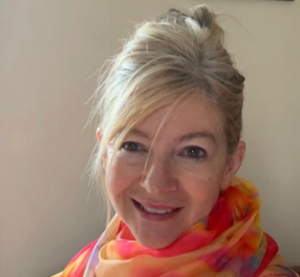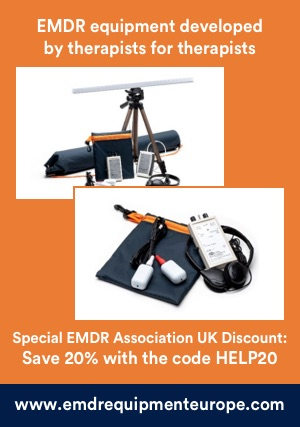
Julie Dorey attended Alexandra Dent’s workshop on EMDR and Spirituality. Spending a wet Saturday in front of her computer did not fill her with enthusiasm but she found that it was time well spent. She gives her view of how it might enhance her practice of EMDR.
Alexandra Dent began by describing her approach to a spiritually informed practice – what she calls a heart-led approach (HLP) and how this can be integrated with other ways of working, specifically with EMDR. Her approach, based on the premise that we are each on an individual life journey, facilitates understanding of our experiences and life lessons. Challenges, trauma or attachment difficulties can create blocks and restrictions which can lead to repeated themes associated with psychological distress (Dent, 2019). Dent’s HLP enables clients to recognise the impact of the ego, encouraging them to step outside and observe these challenges in order to learn the life lesson that each challenge presents; the HLP helps us to honour what feels right from the ‘heart’ or the ‘heart and soul’. This offers new opportunities to recognise and stay with the authentic self rather than be governed by internalised messages from the ego (Dent, 2019/2020).
The presenter explained that within HLP there are two working models: the Heart Led Model (HL) and the Heart and Soul Led Model (HASL) (Dent, 2019). Activating a heart-led system is an alternative way of approaching and understanding challenges as the client is helped to connect to their ‘emotional centre’, the source of love, compassion, inner wisdom and truth. This allows them to become more aware of bodily sensations and positive energies that facilitate positive change, self-growth and authenticity (Dent, 2019).
The HASL may be more appropriate for those clients who are open to the concept of a soul [1]. The HASL model takes into account ‘blocks and restrictions that may have occurred at a soul level from current and past lives and encourages people to live a heart and soul-led life’ (Dent, 2019, p.86). Dent said that she makes most use of the HL model. However, she provided a rationale for remaining open to working at a deeper level using the HASL model and emphasised that this would be client led and based on detailed history taking and assessment.
The client is helped to connect to their ’emotional centre’
These models encourage self-awareness, compassion, mindfulness, developing the authentic self and living a life that is conducive to our inner needs and not those of the ego, which is bound and restricted by memories, experiences, beliefs, assumptions and actions that lock us into negative cycles, diminish our sense of self and cause psychological distress and suffering (Dent, 2019). Although these concepts are shared by most therapy approaches, the framework of these models allows the therapist and client to navigate the therapeutic journey with ease and fluidity. They allow an open curiosity to what might be revealed within the sessions without the restriction of set goals as in more reductionist or top-down approaches. Dent discussed how these models may be integrated with EMDR in Phases 2 (preparation), 4 (Desensitisation) and 5 (Installation) (Dent, 2019) [2].
Dent showed a number of video vignettes from her sessions to demonstrate some of the spiritual interweaves, which were helpful in showing how they can be integrated with EMDR. What was evident from the vignettes was Dent’s complete attunement with her clients. Gently breathing in synchrony with the other allows the energy within the session to remain safely within the window of tolerance or level of autonomic activation (Ogden et al. 2006; Bergmann, 2012) helping the client to experience any trauma (blocks or restrictions) process safely. Respect permeated this co-created and harmonious dyad (Siegal, 1999).
Dent presented other videos which demonstrated what she termed ‘spiritual resonance’ and the use of different spiritual interweaves. One of Dent’s clients who had agreed to be part of the workshop videos joined as a guest speaker at the end of the day. She gave a rich, coherent and heartfelt understanding of how the use of ‘spirituality’ in her sessions allowed her to process trauma and to overcome the huge future challenges that she may encounter in caring for her two children (who have life- threatening difficulties).
I am a beginner in the field of more formalised approaches to spirituality. Working within an NHS Trauma Service, I have been lucky to experience many spontaneous and magical moments in therapy that I might consider to be ‘spiritual’ by nature. These moments have occurred spontaneously and have created positive feelings within the session. In my opinion, and from client feedback, they have enabled improved resourcing and a deeper level of recovery and post-traumatic growth. I see ‘spirituality’ as a meeting of two ‘souls’, to be based on the intrinsic dyadic nature of the therapeutic relationship (Schore, 1994). Attunement encourages an interactive system that is neurally synchronised. This dyadic state of affective regulation and reciprocal stimulation allows ‘both members of the dyad to enter into a symbiotic state of heightened positive affect’ (Schore, 1994, p71). In this unconsciously mediated neural synchronisation of therapist and client, self-exploration and adaptive information processing can occur (Bergmann, 2020).
Bergmann (2020) suggests that dysfunctionally stored information is fragmented from more associative memory networks or neural networks, including images, emotions and sensations related to the experience. The AIP model also emphasises the faulty predictive tendency of cognitions/beliefs. This impaired neural linkage retains the ‘frozen in time’ nature of traumatic or distressing memories. EMDR allows us to move beyond left hemisphere, top-down processing and allows the brain’s own self-healing capacity to occur by ‘right hemispheric primary-processing of embodied emotion, subjectivity and therapeutic intersubjective resonance’. (Bergmann, 2020, p.274).
Since completing the workshop I feel that I am better equipped to respond to clients’ more spiritual needs. I am currently working with a patient who has developed PTSD and a severe death anxiety since recovering from an acute heart problem. He had to wait six months for an urgent heart operation and was informedthat he could die at any moment. He had lived with that fear until his operation but now, two years later, he has remained in that state of fear even though the threat is minimal. He reports ‘every day I wake up and wonder if this is going to be it, I am too scared to do anything .. because I’m not ready to die’. Although we are planning to complete EMDR treatment, it has been useful to be able to discuss death, dying and beyond death beliefs in an open and curious way. I may have avoided such discussions previously as much for my sake as for that of my clients but, by talking things through, a number of ‘spiritual’ moments were recounted and these will, I’m sure, prove to be excellent resources when commencing the core part of treatment. These moments appear to have been pivotal in this client’s trauma journey.
[1] The soul is referred to as ‘the spiritual or immaterial part of a human being or animal, regarded as immortal’ and in HLP ‘an immortal, invisible energy within us connected to our higher selves as well as a higher presence or Divine Source of Divine love that are carriers of memories, experiences and knowledge through different incarnations’ (in Dent, 2019).
[2] For a full explanation of the HLP model, Dent, A. (2020). Using Spirituality in Psychotherapy, The Heart Led Approach to Clinical Practice. Oxon: Routledge
References
Bergmann, U. (2020) Neurobiological Foundations for EMDR Practice. 2nd Edition. New York: Springer Publishing Company
Dent, A. (2019/2020). Using Spirituality in Psychotherapy, The Heart Led Approach to Clinical Practice. London: Routledge
Ogden, P., Minton, K. & Pain, C. (2006). Trauma and the body. New York: Norton
Schore, A.N. (1994). Affect regulation and the origin of the self: The neurobiology of emotional development. Mahwah, NJ: Erlbaum
Siegal, D.J. (1999) A Developing Mind: Toward a neurobiology of interpersonal experience. New York: Guilford Press
Dr Julie Dorey is a BABCP Accredited Psychotherapist, Supervisor and Trainer, and an EMDR Europe Accredited Practitioner. She is a Senior Therapist at the Cardiff and Vale Traumatic Stress Service and an Honorary Research Associate at Cardiff University.







